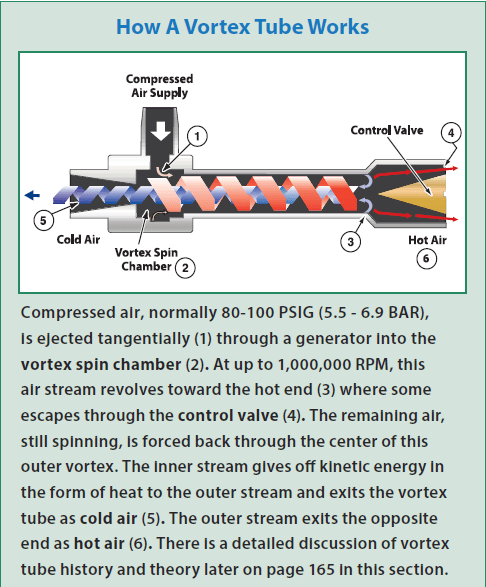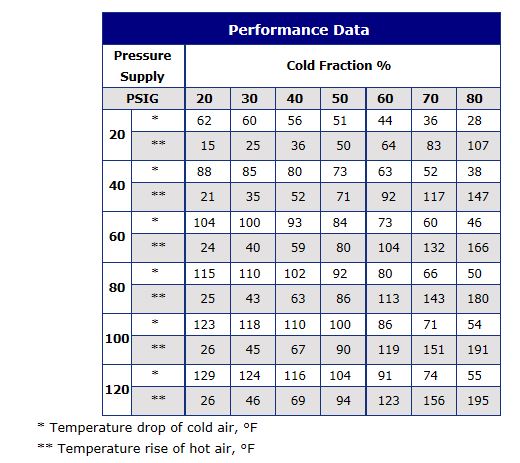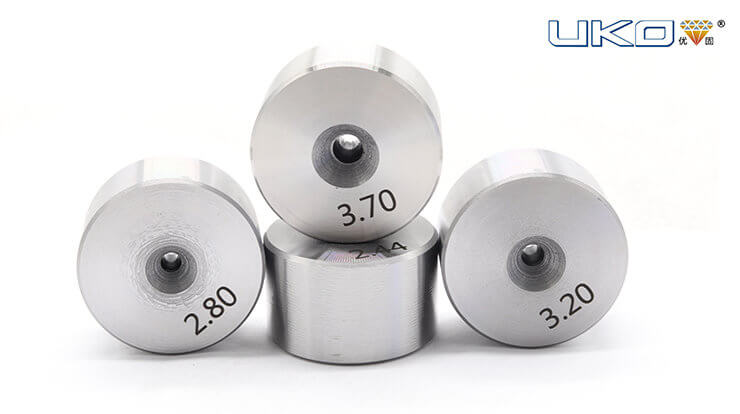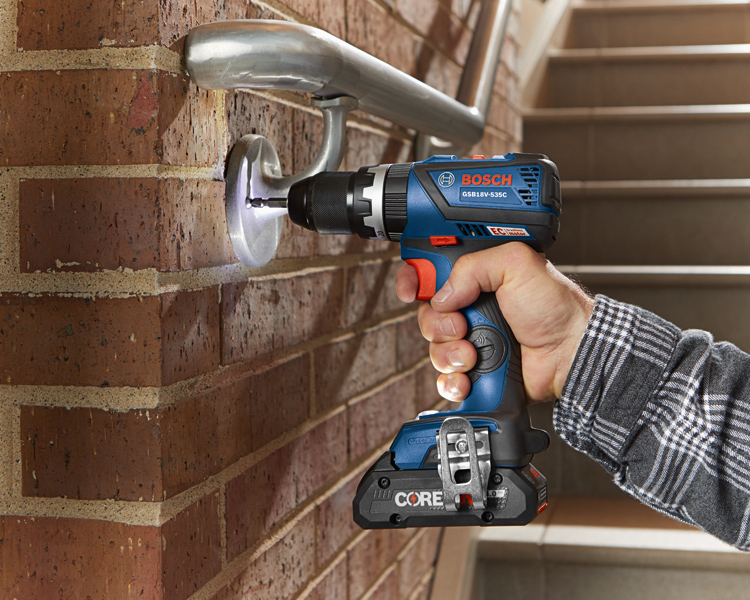The Effect of Back Pressure on a Vortex Tube
Vortex tubes have been considered a phenomena of Physics and boggled minds for many years. To give a brief run down of how the Vortex Tube works please refer to Figure 1 below.

As seen above, the control valve is determining the amount of air allowed to escape the hot end and sets the cold fraction. A cold fraction is the percentage of air that exits the cold side versus the hot side. The cold fraction and operating pressure sets the temperature drop on the cold end and temperature rise on the hot end, as well as volumetric flow out of both ends. The control valve is not the only variable that can alter the cold fraction of the Vortex Tube though.
In Figure 1 and the performance chart below, there is no restriction on the hot end or the cold end outlets. No restriction means no back pressure and the cold air has the easiest path to the area needing cooling. Back pressure can directly affect the performance of a Vortex Tube. As little as 3 psig of back pressure can begin to alter the temperature drop or rise on the Vortex Tube. This is due to the fact that Vortex Tubes operate off an absolute pressure differential. If the outlets have a restriction on them then they are not discharging at atmospheric pressure, 14.7 psi. What kind of items can cause back pressure and can the performance with a back pressure on the outlet be determined?
Back pressure is created by implementing any form of restriction on the hot or cold outlet. This may be undersized tubing to deliver the cold air or a valve that has been installed to try and control the volume of air being blown onto the process as well as many other possibilities. The best rule of thumb to eliminate back pressure is to keep the tubing on an outlet the same cross sectional dimension as the outlet on the Vortex Tube and try to keep the tubing as short as possible.
If back pressure cannot be prevented, the performance variance of the Vortex Tube can be calculated and possibly compensated for. The variables that are needed to do so are the inlet air pressure of the vortex tube and the amount of back pressure that is being seen on the outlets. If this is different from the hot end to the cold end both will need to be known. If these are not known they can be measure by installing a pipe Tee and a pressure gauge. This may need to be a sensitive pressure gauge that measures even relatively low psig. (1-15 psig)
Once these variables are known, we want to look at an absolute pressure differential versus the back pressure differential. For example, the Vortex Tube is a operating at 100 psig inlet pressure, 50% cold fraction and 10 psi of back pressure. We look at the pressure differentials and can use Algebraic method to determine the inlet pressure supply that the tube will actually perform at.
(100 psig + 14.7 psia) / (10 psig + 14.7 psia) = X / 14.7 psia
4.6437 = X / 14.7
X= 14.7 * 4.6437
X = 68.2628
(Values have been rounded for display purposes)
So if there is a 10 psig back pressure on the outlet of a Vortex tube operating a 100 psig inlet pressure the tube will actually carry performance as if the inlet pressure was ~68 psig. To showcase the alteration in performance we will look at just the temperature drop out of the cold side of the Vortex Tube. (Keep in mind this is a drop from the incoming compressed air temperature.)

As shown in the performance chart above, if the Vortex Tube was operating at 100 psig inlet pressure and 50% cold fraction the temperature drop would be 100°F. By applying a 10 psi back pressure on the outlet of the Vortex Tube the temperature will be decreased to ~87°F temperature drop. This will also decrease the volumetric flow of air exiting the Vortex Tube which can also be calculated in order to determine the cooling capacity of the Vortex Tube at the altered state. Keep an eye out for a follow up blog coming soon to see that calculation.
Brian Farno
Application Engineer Manager
BrianFarno@EXAIR.com
@EXAIR_BF


